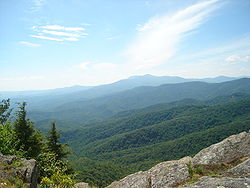Caldwell County | |
|---|---|
 Caldwell County Courthouse in Lenoir | |
| Nickname: The Gateway To The Blue Ridge | |
 Location within the U.S. state of North Carolina | |
 North Carolina's location within the U.S. | |
| Coordinates: 35°58′N81°31′W / 35.97°N 81.51°W | |
| Country | |
| State | |
| Founded | 1841 |
| Named after | Joseph Caldwell |
| Seat | Lenoir |
| Largest community | Lenoir |
| Area | |
• Total | 474.61 sq mi (1,229.2 km2) |
| • Land | 471.89 sq mi (1,222.2 km2) |
| • Water | 2.72 sq mi (7.0 km2) 0.57% |
| Population (2020) | |
• Total | 80,652 |
• Estimate (2024) | 80,739 |
| • Density | 170.91/sq mi (65.99/km2) |
| Time zone | UTC−5 (Eastern) |
| • Summer (DST) | UTC−4 (EDT) |
| Congressional district | 5th |
| Website | www |
Caldwell County is a county in the U.S. state of North Carolina. It is located in the foothills of the Blue Ridge Mountains. As of the 2020 census, the population was 80,652. [1] Its county seat is Lenoir. [2] Caldwell County is part of the Hickory-Lenoir-Morganton, NC Metropolitan Statistical Area.
Contents
- History
- Geography
- National protected areas
- State and local protected areas
- Major water bodies
- Adjacent counties
- Major highways
- Major infrastructure
- Demographics
- 2020 census
- 2010 census
- Government and politics
- Education
- Elementary schools
- K-8 schools
- Middle schools
- High schools
- Alternative schools
- Private schools
- Online school
- Independent school
- College
- Communities
- City
- Towns
- Village
- Census-designated place
- Other unincorporated communities
- Townships
- See also
- References
- External links







